We get it, as a loving pet owner, you just want to bond with your leopard gecko and be able to at least hold it for a while without it getting all squirmy and stressed out. We are here to help you achieve that!
The best approach to easily bond with your leopard gecko is by being patient and allowing it to take all the time it wants to get used to your presence. It is also important to make sure you provide a proper and comfortable environment for your pet to feel safe. Giving it treats can also help!
So, now you know the bare basics about boding with your leopard gecko, but there is a lot more to it, and, in this article, we will discuss each step in detail and give you a few tips to help you build a strong and healthy relationship with your pet. So, keep reading on!
Table of Contents
Steps To Bond With Your Leopard Gecko
First, you need to understand that when your leopard gecko runs away from you or prefers to stay in hiding when you are near its enclosure, it is because they see you as a big and scary creature! (which you are, when you compare your size to your pet’s size).
In the wild, large animals are considered predators by leopard geckos. So, you need to show your pet that you mean no harm and that you are just a friendly giant who they can trust!
So, with that in mind, let’s take a look at the things you need to consider when building a strong relationship with your pet:
1. Make Sure To Provide Adequate Husbandry
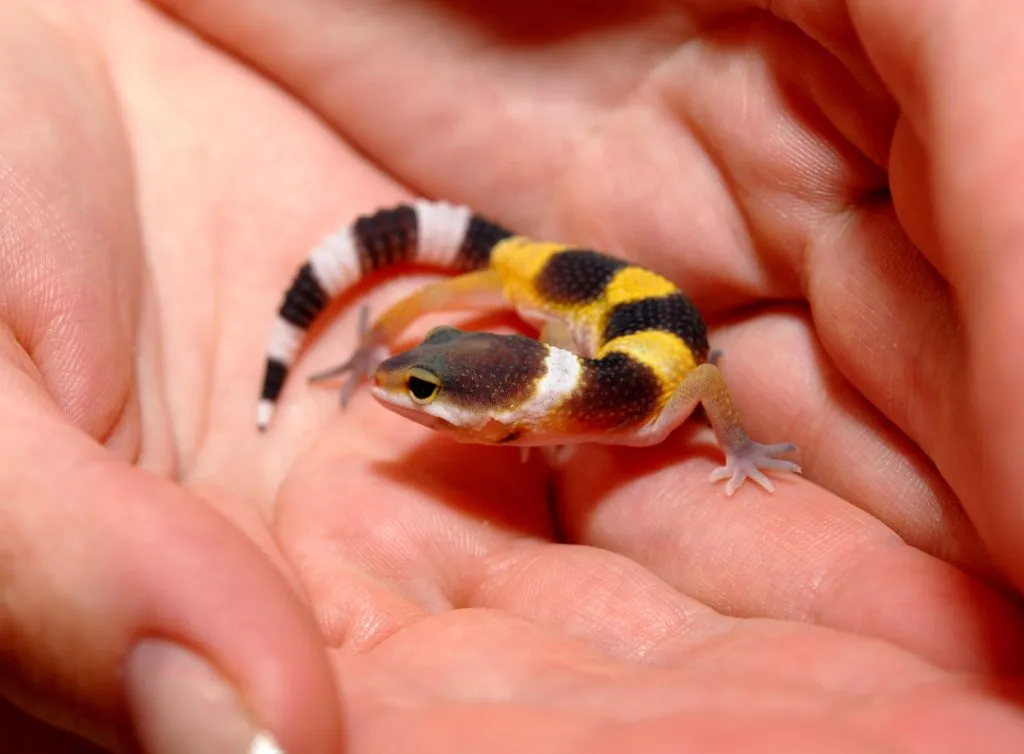
You need to make sure everything is all set up and in order in the enclosure, as any husbandry deficiency will stress your pet and can even make it ill.
Of course, a stressed or sick reptile is not going to be interested in building a bond with a human.
So, check that the humidity level is at an appropriate range, the temperature gradient is adequate, the heat sources are working correctly, there are enough hiding spots, sufficient climbing opportunities, and the enclosure has a reptile-safe substrate for your leo.
The size of the enclosure is also important, make sure to get an adequate-sized
Here is a small table that can quickly guide you about the proper husbandry for your reptile:
| Enclosure size | 1 leo: 36 inches length × 24 inches wide × 12 inches high (60 cm x 60 cm x 30 cm) 2 leos: 90 inches length × 24 inches wide × 12 inches high (90 cm x 60 cm x 30 cm) |
| Temperature range | From 68 °F to 89 °F (20 °C to 32 °C) |
| Humidity | Between 30% and 40% |
| Heating sources | A heat mat covering one-third to a half of the enclosure’s floor, or a heat lamp pointed towards some rocks or slate tiles so they can retain heat |
| Substrate | Large pebbles, slate tiles, reptile carpet, paper towels, or newspaper |
| Hiding spots | At least 3, one on the warmer side, one on the cooler side, and one in the middle of the last two. |
If at any point you notice signs of stress in your leopard gecko, such as glass surfing, excessive licking, or gaping, then you need to double-check all the settings in the enclosure to make sure everything is in order.
Tip: Also read our article about things that will stress leopard geckos!
2. Allow Your Leo To Get Used To Its New Environment
If you just got your leopard gecko, chances are they will be stressed out by a change of scenery and being in an unknown environment.
Maybe you are excited because you spent so much time setting up a nice comfy enclosure for your pet, and now, your leo is just hiding! But that is okay. Give it enough time to get to know its surroundings and realize they are in a safe place.
Three to four weeks should be enough time for your leopard gecko to settle in. Do not make changes in the enclosure during this time.
Remember that any change, as insignificant as it may seem to you, will be a huge and stressful thing for your leo.
3. Allow Your Leo To Get Used To Your Smell
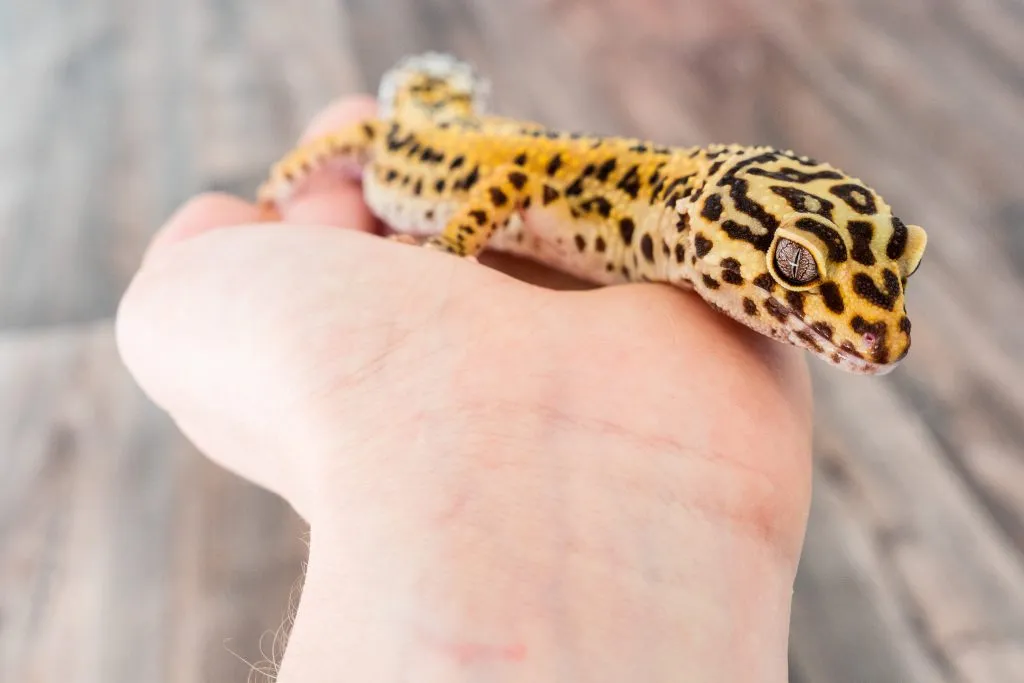
Leopard geckos can recognize smells and eventually learn to associate them with good or bad experiences. So, when they smell something new, they can get uneasy.
You can take advantage of this and let your leo get used to your smell from early on by leaving a piece of the clothes you wear every day near its enclosure.
That way, your pet will get used to your smell and will learn that nothing bad happens when you are around.
4. Get Your Leo To Recognize Your Voice
This is one of the most fun ways to bond with your leopard gecko!
Since leos have a good sense of hearing, another key part of getting your pet to bond with you is by letting it recognize your voice and be comfortable when hearing it.
Just make sure to speak using a soft and calm tone. Do not scream or make any loud noises as this can easily scare your leo.
Call your leopard gecko by its name and talk with it every day. You can also create a special sound that they will eventually recognize and even respond to!
Of course, they won’t be able to vocally respond to it, but they can look at you or even come running to you after hearing it.
This sound does not have to be something elaborate. Just a tongue click, a snap, or a humming sound can be enough. Just make sure it is not too loud, so your pet does not get scared or stressed when hearing it.
Use this sound when feeding them so they can learn to associate it with a good experience.
5. Respect Their Resting Time
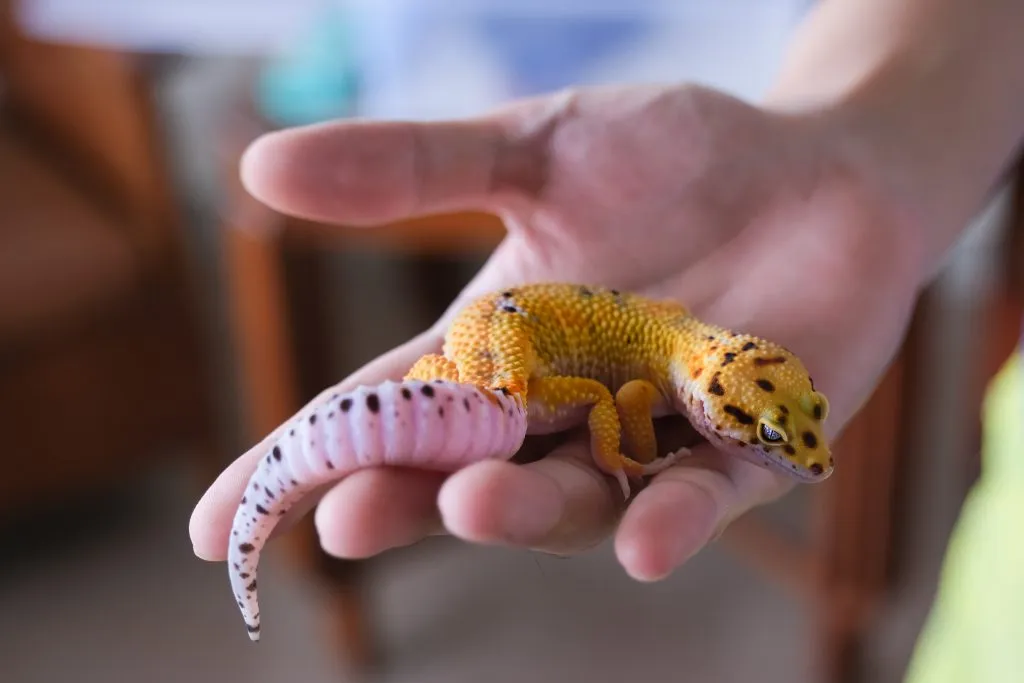
This is one of the most difficult tasks that eager reptile owners experience after getting a leopard gecko.
Since these reptiles are crepuscular, meaning that they are more active at dawn and dusk, you need to let them rest during most of the day.
We know you want to interact with your new pet, look at it, and just bond with it as much as you can, but it is essential that you allow them to get proper rest in between.
Think about someone coming to your bedroom and bothering you in the middle of the night just when you were sleeping soundly and getting a good night’s rest. Now, that would not be very nice, would it?
Well, the same happens to your leo when you come bothering it in the middle of the day. They won’t get to like you very much if you keep doing that.
So, what can you do?
Try to bond with your pet while it is fully awake and most active, which is during the early morning and evening hours. Do not disturb your leo when it is trying to sleep.
If you need to do some work in the enclosure or around it, that is fine, but try to do it as quietly as possible.
6. Bribe Your Leo With Treats!
You can start by leaving
After that, you can start using tongs or tweezers to feed your leo, or can even hand-feed them if they allow you to.
However, only being present when your pet hunts by itself is enough to create a positive relationship, as it learns to associate you with feeding time.
Offering some treats to your leo can further strengthen the bond between the both of you. Just make sure to not overfeed your leopard gecko by giving it too many!
Good treats include crickets, waxworms, and mealworms. Make sure the insects are no larger than half the size of your leo’s head, that way you will prevent it from accidentally choking on its
Feeding time is also a good time to practice your special sound that we talked about earlier in the “Get Your Leo To Recognize Your Voice” section of this article!
7. Learn How To Handle Your Leo Safely
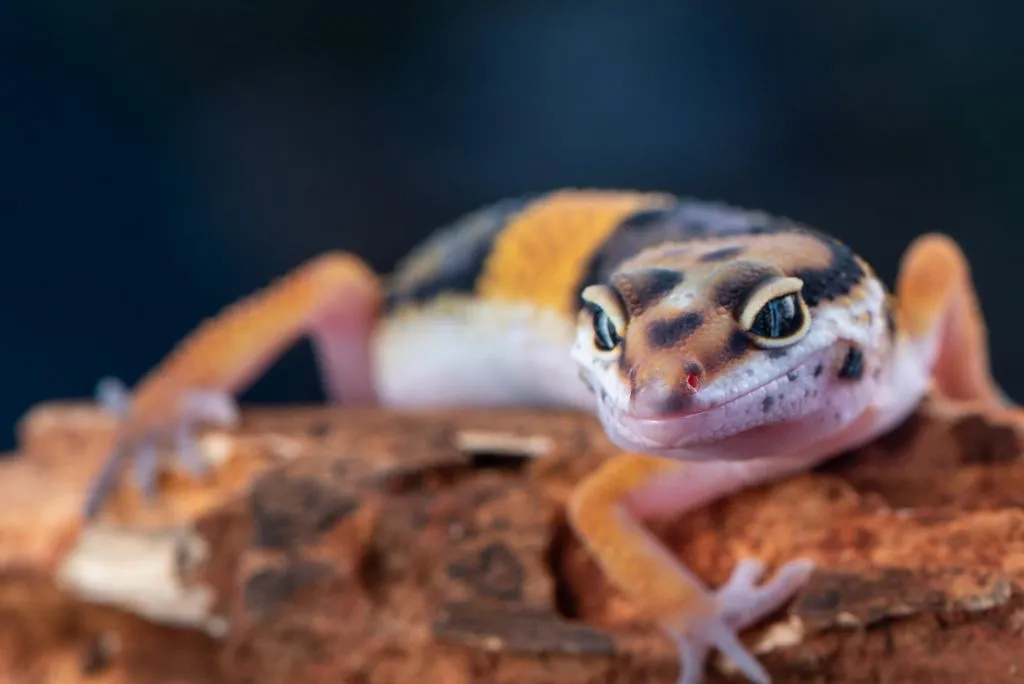
So, once you notice your leopard gecko is comfortable around you and does not run away every time it sees you, you can start getting closer to it by putting your hand in the enclosure and just letting it rest there without moving it.
Do this for a few minutes each time until you notice your pet is relaxed and not bothered by your hand at all. Let your pet come close and inspect your hand on their own time.
Patience is key in this step, some leos are more adventurous than others. Do not move your hand to try to get your leo’s attention, as this will only be counterproductive for the bonding process.
For the same reason, you should never move your hand if your pet tries to lick it.
This is the time when you can start putting
Once you have succeeded in making your leo get comfortable around your hand and eat from it, you need to keep practicing your patience skills and suppress the urge to scoop it up from the enclosure.
Instead, let your leopard gecko climb, lick, and/or sniff your hand and arm for a few times first.
Now you are all set! you can attempt to lift your leo from its enclosure.
We recommend using the “scooping” method, with this method, you need to cup your hand and carefully put it in front of your pet, then slowly slide it underneath its forelegs. That way, you will encourage your pet to hop into your hand by itself.
If, for any reason, you need to pick up your leopard gecko without waiting for it to crawl into your hand by itself, then you can approach it from its front or side, making sure they notice what you are doing, and firmly grip it from its midsection.
Once you have secured your pet with your fingers, you can gently lift it up. Cup your free hand underneath your leo in case it starts getting squirmy and accidentally falls down.
Tips To Handle Your Leo
Here are a few tips that can make handling your pet a more enjoyable experience for both of you:
- If possible, try to start handling your leopard gecko from a young age. This will contribute to it getting used to being handled and being more calm and docile when older.
- Warm up your hand before holding your leo. This can make it feel more comfortable and encourage it to stay in your hand for a bit longer.
- Avoid startling your pet before handling it. Make sure they notice you are around before attempting to interact with them.
- Always be gentle and make slow movements when you are around your pet. Sudden movements will make it feel scared and threatened.
- Try to handle your leo before feeding it, not immediately afterward, as doing so can lead your pet to regurgitate its
food or relieve itself on your hand.
- Never attempt to lift your leopard gecko from its tail. These reptiles have autotomy, meaning they can voluntarily get their tails detached when feeling threatened.
- Never pick it up from above. If you try to do this, your pet may think you are a predator that is trying to attack it and will get nervous and stressed out.
- Be mindful of your strength while holding your leo. Make sure to be gentle and do not hold them too hard.
8. Allow Your Leo To Explore
Once your leo gets comfortable enough around you, let it explore!
These reptiles are curious by nature, so your leo may decide to start crawling up your arms, shoulders, and neck.
Eventually, your pet may even relax or fall asleep whenever they feel is the warmest spot in your body.
You can also allow it to explore the room you are in or take it outside for a little while. Just keep an eye on your pet so it doesn’t get lost, and make sure that no potential predators are around.
9. Recognize When Enough Is Enough
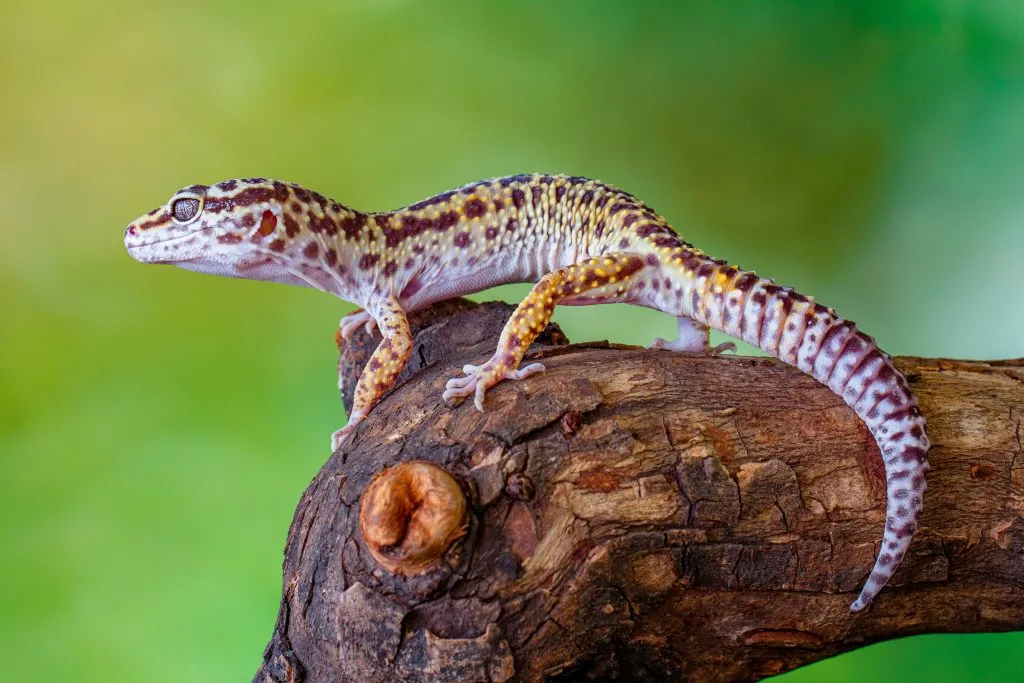
If you notice your leopard gecko starts getting stressed, tired, scared, or uncomfortable, take it back to the enclosure and leave it alone for a while.
The same applies if your leo starts running away from you or does not allow you to pick it up.
In some cases, your leopard gecko may get uncomfortable because the temperature outside the enclosure is too high or too low for their liking.
Signs that your leo may have had enough include wagging its tail, hissing, mouth gaping, squeaking, arm waving, and excessive licking.
Managing Your Expectations
As we stated before, bonding with your leopard gecko can take a lot of time, usually months.
So, do not try to rush things, as doing so can only cause setbacks in your progress and cause your pet to become stressed.
Keep in mind that, despite everything, your leopard gecko is a reptile, not a dog; and this means that they are solitary creatures by nature.
However, you should not get discouraged. With a lot -a lot- of patience and consistency on your part, you can get your pet to like you and achieve a strong friendship relationship with you.
How To Know When Bonding Has Been Successful
Leopard geckos are very curious, active, and expressive reptiles by nature. So, you will notice when your pet feels safe, relaxed, and comfortable around you.
You can test this by taking note of its behavior during feeding time, if it eats from your hand or hunts when you are around. Then, cheers! Your pet trusts you!
You will also notice that your leo gets interested in you and will step out of its hiding spot or stop what it is doing to come to greet you after realizing you are in the room.
Another sign of a successful bonding is that your pet will not hesitate to jump into your hand and climb all over you once you take it out of the enclosure. This is considered the ultimate sign of a strong and healthy relationship between you and your leo! Congratulations!
- Enchi Ball Python: A Unique and Stunning Morph of Python regius - March 27, 2025
- Emerald Tree Monitor: The Enigmatic Green Guardian of the Rainforest - March 26, 2025
- The Egyptian Cobra (Naja haje): A Fascinating Serpent - March 25, 2025
